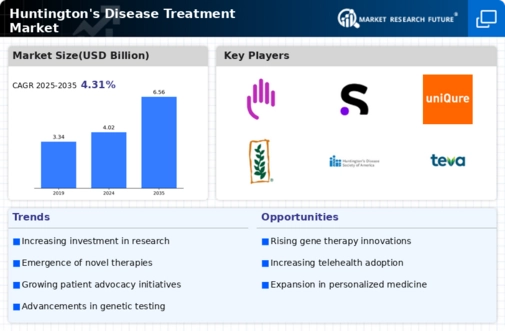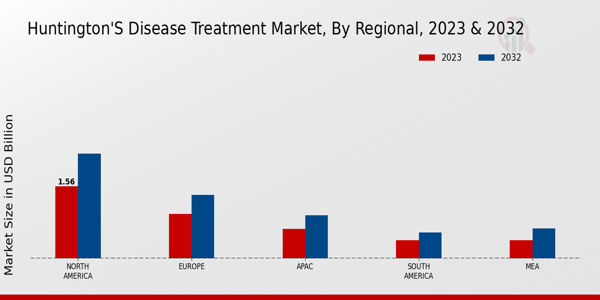Huntington S Disease Treatment Size
Huntington’s Disease Treatment Market Growth Projections and Opportunities
The size of Huntington’s Disease Treatment Market is anticipated to reach USD 2.9 Billion by 2027 at a CAGR of 17.7% over the forecast period 2023-2032. The growth and dynamics of the market for Huntington's disease treatment are determined by a range of factors. In this context, one key driver is the fact that Huntington's disease, an inherited and rare neurodegenerative disorder characterized by gradual loss of ability to walk or speak coupled with dementia symptoms is common in people who are affected by it. As medical science has not yet found any cure for Huntington’s Disease, there is now increasing demand for therapeutic interventions that will reduce symptoms and improve the quality of life for sufferers from this tragic affliction including symptomatic management, physiotherapy, palliative care as well as research medications aimed at various aspects of the complex pathophysiology involved with this syndrome. Technological advancements play a pivotal role in shaping the disease treatment market for Huntington's disease. Innovations in neuroscience research, gene therapy and neuroprotection have enabled the development of more targeted disease-modifying therapies. Furthermore, advanced molecular and genetic technologies have yielded valuable insights into the genetic basis underpinning this illness paving the way for personalized medicine approaches based on a patient's own biology. Regulatory considerations are crucial in influencing the market dynamics of Huntington's disease treatments. This includes strict regulations and approvals being necessary to ensure safety and efficacy of such treatments by manufacturers. In addition to establishing credibility for huntington's therapeutics only compliance with regulatory requirements also instills confidence among doctors as well as patients fueling market growth thereof. They affect economic factors such as health care spending levels and funding available for orphan diseases when considering integrating modern methods such as those used to treat HD into normal medical practices such as reimbursement policies or coverage affecting their financial feasibility The availability & affordability of these drugs depends on economic considerations relating either directly (as seen e.g. in the case of the US) or indirectly (due to unique local circumstances such as infrastructure limitations) to their accessibility by patients as well as take-up among health professionals that is still low because of high cost and other challenges associated with orphan disease management mainly in developing countries. This has led to market fragmentation across different regions where various barriers need to be surmounted in managing Huntington’s disease. Here, prevalence levels for HD, demographics and health care delivery systems differ from one country or region which have a bearing on what types of treatment are needed most urgently. In order to meet the needs of specific markets, manufacturers often design strategies that help them navigate through regulatory requirements applicable to each market. Competitive dynamics play a role in fostering innovation and market expansion in the Huntington's disease treatment segment. Key pharmaceutical companies, academic research institutions, and advocacy groups drive drug development and commercialization strategies. Collaboration between these parties stimulates new forms of care, improved therapeutic approaches, better drug formulations thus making it possible for healthcare providers who treat Huntington’s Disease an array choices at their disposal.
Subsequently, continuous improvement of technology due to research and development activities supports market evolution in Huntington’s disease treatment space. This is reflected by ongoing attempts at finding agents capable of changing the course of HD while also improving its symptomatology through better therapies including targets for novel treatments offered by this industry sector today. Research-driven innovations help create solutions that are more responsive both to emerging trends among healthcare providers involved primarily with treating HD but also adapt over time based specifically upon evolving patients’ expectations concerning more effective handling options available within their reach.

















Leave a Comment